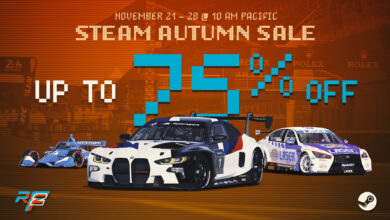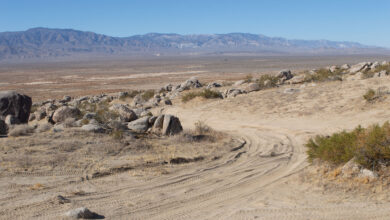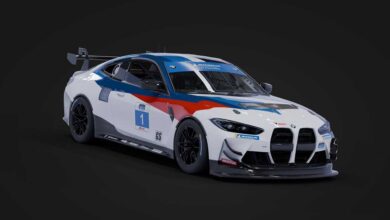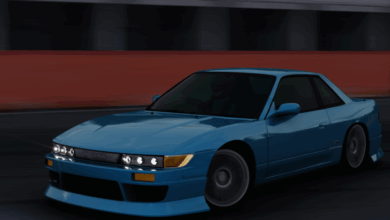Ascher Racing McLaren Artura Ultimate Steering Wheel – SimRaceBlog
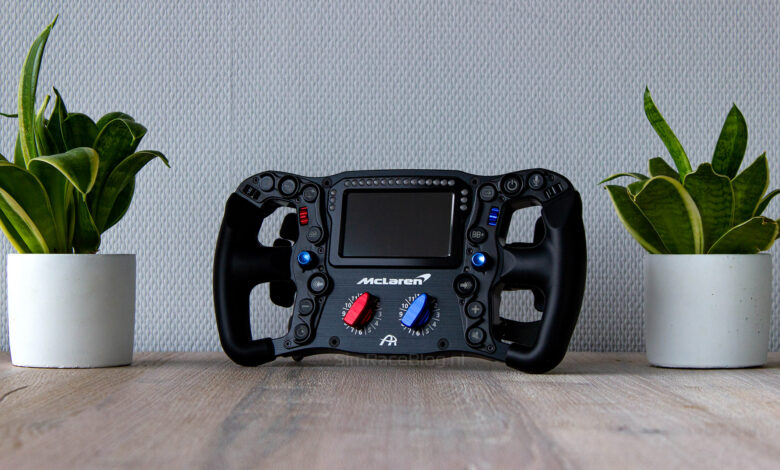
Ascher Racing is a well-known name in the sim racing world thanks to their high-quality steering wheels. Previously, we had the chance to review Ascher’s Artura GT4 wheel and the Artura Pro wheel from their new McLaren Esports series. The third wheel from the Ascher Racing Artura Esports series that we get to review is the most complete one yet, with a fitting name: the Ascher Racing McLaren Artura Ultimate steering wheel.
To make this review the ultimate experience too, we’re going to test the wheel with all available optional extras. That means we’ll be fitting a custom front plate, using the optional knob kit, and, of course, mounting the specially designed Ascher Racing Quick Release for Asetek wheelbases.
The base model of the McLaren Artura Ultimate is available in Ascher Racing’s webshop for a price of €1499. The knob kit costs €99, and the Asetek Quick Release is priced at €119. All mentioned prices include 19% VAT but exclude shipping costs. If you choose to order a custom Ultimate steering wheel, it’s available starting at €1699. With this, you get a personalized front plate and can choose the button colors straight from the factory, so you won’t need the knob kit anymore. If you use the discount code SIMRACEBLOGNL during checkout, you’ll get 5% off your order.

Packaging & Contents
From Germany, the package takes about three days to arrive at our door in the Netherlands. The FedEx courier hands us a brown shipping box, inside of which we find some protective material and, of course, the product box.
The product box for the McLaren Artura Ultimate steering wheel is exactly what we’ve come to expect from the other wheels in the Artura Esports series from Ascher Racing. The box is wrapped in a nice black-colored sleeve featuring a prominent photo of the steering wheel on the front, with a McLaren Artura slightly in the background. At the top, the product description is printed in white letters, and at the bottom, you’ll find the Ascher Racing and McLaren branding. On the back of the sleeve, there’s another close-up shot showing the right half of the wheel, along with an overview photo of the original steering wheel from the McLaren GT4. Below that, four highlights are explained, each with supporting detail photos.
Inside the sleeve, you’ll find the standard black product box with white branding, which is used for all steering wheels in the Artura Esports series. However, this time, it includes the white cross behind the “Artura Ultimate USB.”





When opening the box, we find a quote from owner Martin Ascher on the inside of the lid: “Racing in perfection is what drives me forward”. Looking further into the box, the first thing we spot is a sheet of stickers sitting on top of a second lid. This second lid has an outline drawing of the steering wheel, along with a few keywords about the wheel and a viewing window. Through this window, we can already see the steering wheel, neatly lined up with the outline printed on the lid.



Underneath the second lid, alongside the steering wheel, we find a coiled USB cable, a USB extension cable, a short USB-C to USB-C cable, and three small bags.
One bag contains mounting materials, another holds the necessary tools, and the last one has the interchangeable button caps.




The Ascher Racing McLaren Artura Ultimate steering wheel
As we mentioned in our earlier reviews of the McLaren Artura Esports Series, all the steering wheels are based on the real GT4 wheel of the McLaren Artura. This wheel was developed in collaboration with Ascher for the GT4 car and later adapted for sim racing, with the Ascher Racing McLaren Artura Ultimate steering wheel fully tailored to the needs of sim racers.
When we place both wheels side by side, the similarities and differences become clear. Both wheels are made from the same motorsport-grade materials and have the same 300mm diameter. They also both feature the same rubber grips. However, one difference that immediately stands out is the shape of the wheel.
Where the GT4 wheel has a clear butterfly shape with a narrower center compared to the outer edges, the Ultimate wheel is the opposite — it has a thicker center section. Visually, this makes sense since the Ultimate wheel is much more packed with input options and is also equipped with a display.
We’ll take a closer look at all the features of the Ultimate wheel below.

The front
When you look at the front of the Ascher McLaren Artura Ultimate steering wheel, it’s immediately clear that this is a feature-packed wheel. The wheel is fitted with no less than fourteen push buttons, each equipped with LED backlighting. Combined with the partly transparent button caps, this makes the buttons easy to see and recognize, even when the room is darker. The push buttons are neatly divided into seven on the left side and seven on the right side of the wheel, all placed within a plastic guard to help prevent accidental presses.
Besides the push buttons, the Ultimate wheel also features four thumb encoders. On each side of the wheel, you’ll find one thumb encoder placed both above and next to the thumb hole for easy access. Next to the thumb encoders, there’s also a 7-way Funky Switch on each side. These joysticks can be pushed in four directions, rotated in two directions, and pressed like a button.
The last input options on the Ultimate wheel are the two very recognizable red and blue rotary encoders at the bottom of the wheel. These rotary encoders can be used either as position-based encoders or as pulse encoders. That means you can choose whether the encoder holds a fixed position after turning, giving you twelve individual inputs, or whether it sends a “+” or “-” pulse depending on which way you turn it.




The Ascher McLaren Artura Ultimate wheel doesn’t just offer input options on the front. The Ultimate version sets itself apart from the other Artura wheels by offering visual feedback. The biggest eye-catcher is, of course, the 4″ VOCORE screen, which sits neatly nestled into the front plate of the wheel. The touchscreen is fitted into a sleek plastic frame and is partially recessed into the wheel for a clean look.
This plastic frame doesn’t just hold the screen; it also houses the 21 RGB LEDs. At the top of the frame, there are fifteen LEDs used as rev lights, and on both the left and right sides, there are three vertical LEDs that function as flag lights.
All of this is mounted on the wheel’s aluminum front plate. By default, this front plate features the McLaren logo between the screen and the rotary encoders, the Ascher logo below the rotary encoders, and numbering around the encoders themselves. We say “default” because Ascher now also offers the option to create a custom front plate through their configurator. This lets you add your own text or logos where the standard branding would be. The wheel then gets delivered directly from Ascher with the custom front plate already installed. Since we received our custom plate a little later, we’ll be installing it ourselves at a later stage.




The rear
The back of the Ascher McLaren Artura Ultimate wheel is also packed with features. On the rear side of the wheel, you’ll find six paddles, split into three on each side. The top two paddles are each mounted on Ascher’s new sixth-generation shifter modules. These modules use Hall sensors to send the signals and magnets to create resistance when pressing the paddles. This makes them much more durable than conventional micro switches. A new addition to this latest generation is the small rubber stoppers that help to reduce noise compared to earlier versions.
The top paddles on the back of the wheel act as two extra function buttons, easily operated with your index fingers. On the same module as these top paddles, you’ll find the gear shift paddles. These are a bit larger than the top paddles and sit slightly closer to the wheel, making it much less likely you’ll hit the wrong paddle when trying to shift.
The lower paddles are for the clutch. The wheel features a dual-clutch system, meaning there’s a clutch paddle on both the left and right side. These are equipped with torsion springs to give them resistance.
The backside of the wheel offers more than just input options. You’ll also find a connector for the coiled USB cable to connect the steering wheel to your PC. There’s also a large central hole housing a USB-C port, specifically made for the Asetek Quick-Release (QR) system. Around this central hole is a 6 x 70 mm bolt pattern, compatible with most popular QR systems. Out of these six holes, three are threaded for mounting from the outside, while the other three are unthreaded to allow mounting from the inside.




Assembly
Before we start using the wheel, there are still a few things that need to be assembled. Since we received our custom frontplate separately, we begin by replacing it and also swap out the thumb encoders and colored rotary knobs on the front of the wheel. Once we’ve done that, we make the wheel ready for use by installing the QR system. Because we won’t be replacing the button caps on the push buttons for this wheel, we’ll refer you to our review of the Ascher McLaren Artura Pro steering wheel for an explanation on that.
Mounting the frontplate
As mentioned earlier, we received our custom frontplate separately. Although it’s not necessary to open the wheel when you buy a wheel with a custom frontplate, it does give us the perfect opportunity to take a look inside the wheel. Following Ascher Racing’s manual, we carefully disassemble the components of the wheel until we’re left holding just the frontplate. At first, it seems like we only need to remove the frontplate, but since both the screen and the thumb encoders are screwed onto it and their connectors are on the back of the PCB, we have to take the whole steering wheel apart. After grabbing the new frontplate, we start reassembling each component one by one. An advantage of this process is that since we had the thumb encoders separated on the table, we were able to take our time and add the gold-colored gears, which we’ll talk more about in the next section. With the screen and thumb encoders screwed back onto the frontplate, we can carefully lower the PCB back into place and screw it back in securely. Finally, we just need to reconnect the plugs for the thumb encoders, screen, shift modules, and clutch paddles before we can close the wheel up again.


Using the knob kit
In addition to the personalized frontplate, we also received the optional knob kit from Ascher to fully customize our wheel to our liking. This knob kit consists of four gold, three red, three blue, and two black gears for the thumb encoders. It also includes two gold, two black, one red, and one blue knob for the rotary encoders on the wheel. Lastly, the kit contains two gold, two red, and two black caps for the funky-switches. The uneven number of colors corresponds to the colors that come standard with the Ascher wheel. With the standard wheel and this knob kit, the wheel could be fully customized in gold, red, blue, or black.
However, we should make a small note here. While all the colors in the knob kit are exactly the same, it’s possible that the blue or red colors in the knob kit may differ slightly from the colors that come standard on the wheel. This is because anodizing metals is a very sensitive process, where even a fraction of a second longer in the liquid can result in a color variation.

We’ve decided to customize the wheel with all gold accents. Replacing the knobs on the rotary encoders is the easiest task. They’re secured with a single screw, which is easy to access. For installing the new knobs, it’s recommended to place a small card or similar object underneath the knob. This way, the new knob won’t make contact with the front plate of the wheel, keeping it free from friction and potential damage. The caps for the funky-switches are also relatively easy to replace, although the screw is a bit trickier to access. Both when loosening and tightening the screw, we need to hold the cap in place to prevent possible damage to the joystick.
The thumb encoders, however, are a whole different story. As we briefly mentioned in the previous section, we replaced these when the wheel was open. This seems to be the exact procedure when replacing the gears on the thumb encoders. The wheel needs to be fairly disassembled to remove the thumb encoders from the front plate, after which the gears can be swapped. Once they’re replaced, it’s crucial to align the encoders back properly. Due to the construction of the mounting bracket, the encoder can shift slightly in its seat. It’s important to align it correctly with the slot in the front plate where the gear passes through to prevent it from rubbing. But that’s not the only thing to watch out for; we also need to be careful when tightening it. If the encoder is tightened too much, it becomes harder to operate. If it’s not tightened enough, it will move around during operation. We recommend thinking carefully about the color choice for the thumb encoders because it’s quite a job to replace them.
All in all, we spent a little over an hour modifying the wheel, transforming it from the standard version to our own personalized version. And we think the result is definitely worth it.


Mounting the Quick-Release
Attaching our Asetek Quick Release system is, once again, very straightforward. Unlike the GT4 version of the Ascher wheel, the Ultimate has six mounting holes instead of three. This makes it easy to attach the QR from the outside without having to open the wheel. Since we’re using the specific Asetek QR for Ascher wheels, we first need to plug the included USB-C cable into both the wheel and the QR before securing the QR to the wheel.
If a different QR system is used, the USB curl cable should be used to connect to the PC, which can be screwed into the underside of the rear of the wheel.


Software
Like the other wheels from the Ascher McLaren Esports series, the Artura Ultimate wheel is also easy to add to SimHub. We navigate to the Devices menu, click on Add Device, and then we can select the Ultimate wheel from a list.

In principle, the wheel is already ready for use. To get the most out of the Ultimate wheel, we of course want the dashboard to provide us with the correct information. Since the integrated screen is also controlled by SimHub, it is possible to display any dashboard of choice. Because we like to use the corresponding dashboard for this wheel, we download the Ascher dashboard from their support page.
By simply running the downloaded file, the dashboard is implemented in SimHub, and we can select it for display.

In addition to controlling the screen, SimHub is also used for the Artura Ultimate steering wheel to manage the backlighting of the buttons. When we navigate to the LEDs tab, we can adjust both the brightness, the color of the buttons, and the lighting effects we want for the buttons. For those who are not yet familiar with SimHub, it might seem a bit overwhelming at first, but it is definitely worth taking the time to explore it.


Finally, the steering wheel also uses Ascher’s own software called Ascher Racing Control Center. This software, which can easily be downloaded via Ascher’s support page, covers more of the wheel’s functionalities. For example, within this software, we can choose whether we want to use our encoders as a position switch or pulse encoder, and adjust the corresponding pulse width. We can also adjust the engagement point of the clutch and choose whether we want the master clutch on the left or right side of the wheel.
If you’d like to go into more detail on this, we refer you to the review of the Artura Pro steering wheel, where we dive deeper into the software.
Using the McLaren Artura Ultimate steering wheel
After we’ve neatly prepared everything, we can start using our Ascher Racing McLaren Artura Ultimate steering wheel. We’ll be using the wheel in both iRacing and Assetto Corsa Competizione.
The first thing we notice is that the steering wheel, including the Quick-Release, feels quite heavy. This feeling turns out to be accurate when we place the wheel on our kitchen scale and the total weight comes out at exactly 2100g. This shouldn’t be a problem, as most of the weight is centered in the wheel and doesn’t cause much inertia during rotational movements. Also, high-end steering wheels like this are rarely mounted on wheelbases with low torque, so the weight is less of an issue in that case.
Mounting the wheel on our wheelbase is also very easy. With the Asetek Quick-Release, it’s literally just a click to attach the wheel to our base, and it’s ready for use without needing any additional cables connected to the wheel. We also have to admit that the wheel looks amazing on our rig.

Of course, we are much more interested in using the steering wheel, and it definitely doesn’t disappoint with the first impression. Although it’s not a surprise for us due to our experience with the other steering wheels from the McLaren Artura series, the steering wheel is once again a pleasure to hold. The wheel has a comfortable diameter, and the rubber grips feel incredibly smooth. Perhaps even more importantly, the rubber grips never feel sticky during longer racing sessions. This means we have a great user experience both with and without gloves.

The front
The excellent user experience is further enhanced by the buttons on the front of the steering wheel. The wheel is very ergonomically designed. Every button on the wheel is easy to reach with our thumbs without having to let go of the wheel. This, combined with the bright colored backlighting, ensures that the buttons are easily operable without having to look at the wheel too much. The buttons themselves have a pleasant resistance and a relatively short travel, combined with an audible and tactile click.
However, it’s not just the buttons that are well placed—the thumb encoders are also easy to operate with minimal effort, as they are positioned right next to the thumb holes on the wheel. Aside from the fact that these encoders are in a great spot, they are also very pleasant to use. The resistance of these thumb encoders is high enough that we won’t accidentally press them, but they’re certainly not too stiff. Additionally, with every twist, there’s a clear click, allowing us to adjust things like brake bias, traction control, and ABS in clear steps.
In addition to the thumb encoders, the wheel also features the “regular” rotary encoders. These are by far one of our favorite rotary encoders in sim racing. Besides the fact that we’ve equipped them with gold-colored metal buttons, these rotary encoders feel incredibly premium. The resistance when turning and the feedback that comes with it is a joy for us with every use. This encoder clicks nicely into the next setting, and there’s a clear audible and tactile click. The distance between the different settings is large enough to prevent it from being accidentally turned too far. In fact, even if we want to turn it quickly by half a turn, every setting we pass is clearly noticeable. What also contributes to the user experience is that these rotary encoders don’t have a round knob, but the knob is shaped like an arrow. This makes it easy to tell, by feel alone, which setting the encoder is on, and it’s easy to rotate it to the desired setting, even if it’s a few steps further. For this reason, we also use these encoders as switch selectors rather than pulse encoders, which is something we often do on other steering wheels.
Finally, on the front are the two Funky-Switches. We appreciate that there are two of them, so we can use one for in-game menus or the black box during driving, and the other for the in-game dashboards of the car. Again, all we can say about these Funky-Switches is that they are well placed on the wheel, making them easy to operate in all directions. What also satisfies us is that the Funky-Switches aren’t too loose. They feel firm, don’t have too much play, and can certainly be used as buttons with confidence.

The unique features that distinguish this steering wheel from the other wheels in the McLaren Artura series are the 4″ screen and the LED lighting found on the front of the wheel. Although we were already very satisfied with the Ascher Racing McLaren Artura Pro steering wheel, which is essentially the Ultimate wheel without the screen and LED lighting, and couldn’t really find any significant downsides to it; the screen and LED lighting truly elevate the wheel to the next level.
The 4″ VOCORE screen at the heart of the wheel is a good size and has a very clear display. Combined with the Ascher Racing dashboard on SimHub, we have all the information we need clearly visible on our screen. Despite some information being displayed in relatively small letters, it is still clearly legible and logically placed. One feature we particularly like in the dashboard is that certain adjustments are displayed in large numbers on the screen. When we shift our brake balance, it is displayed in bold digits on the screen. Also, when using the clutch, an additional overlay appears on the dashboard. At the bottom of the screen, a green bar appears, showing the percentage corresponding to how far the clutch is engaged, which is very useful when adjusting the clutch engagement point.
The screen is also accompanied by the necessary LEDs, in the form of rev lights and flag lights. Their functionality is exactly what we expect. The RPM corresponds well with the game, and in situations where a flag is waved, the color of the flag is clearly visible next to the screen. One thing that is worth mentioning is the brightness of the LED lighting. Every steering wheel uses lighting in its own way. Some wheels use individual “bare” LEDs that shine directly through the wheel, while others have a cover to hide the LEDs or use a completely different system. In the case of the Artura Ultimate steering wheel, there is a small plastic cover over each individual LED, which is intentionally scratched. This is similar to how we use it on traffic lights in the Netherlands. This design prevents us from being blinded by the high brightness of the LEDs, while still making the lighting very bright and clear, regardless of whether it’s light or dark in the room. A small detail that pleasantly surprised us



The rear
The back of the steering wheel is where Ascher Racing truly excels. Ascher is known for the high-quality shift modules they use in their steering wheels, and this steering wheel is no exception. The use of both the shift paddles and the function paddles above them is, once again, a pleasure. Despite the additional rubber dampers in the module, the paddles feel solid and don’t become numb or soggy. And while a shift module will never be completely silent during use, we can confidently say that this new generation of Ascher shift modules produces significantly less noise than many other steering wheels.
The small details really matter, and we’d like to point that out as well. The slight depth difference between the positioning of the shift paddles and the function paddles makes a noticeable difference under the fingers. Even though these paddles are almost seamlessly stacked on top of each other, this small depth difference ensures that it’s clearly felt where one paddle starts and the other ends. But that’s not all, because due to the depth difference, it’s nearly impossible to accidentally engage the wrong paddle. We are continually impressed by how premium these modules feel, and we consider these modules a benchmark for how shift modules should feel.
Below the shift modules are the clutch levers. In our opinion, these somewhat contrast with the other components on the back of the wheel. While the shift paddles and function paddles are positioned at a comfortable distance from the wheel, the clutch levers feel quite far back. We have to reach quite far back with our hand to engage the lever, and we see this as a challenge for people with smaller hands. Nevertheless, the clutch levers feel solid and have a nice resistance during use. However, the position and long throw of the lever make it harder to develop a proper feel for it.

Conclusion
With the completion of the review of the Ascher Racing McLaren Artura Ultimate steering wheel, we come to the end of the reviews from the Ascher Racing McLaren Esports Series. And in this case, we’ve definitely saved the best for last, as this is indeed the ultimate version of a series of very high-quality steering wheels.
From unpacking the box to actual usage, everything about the Ascher Racing McLaren Artura Ultimate steering wheel is meticulously arranged. The steering wheel is packaged neatly in a box with all the necessary accessories included.
The 300mm wide steering wheel feels great and is also easy to equip with a Quick-Release system thanks to the hole pattern on the back. It’s even easier when using the Asetek QR for the McLaren Esports series, as no cables are required to connect the steering wheel to our computer.
During use, everything falls perfectly into place. Thanks to the well-placed buttons, thumb encoders, and rotary encoders, the steering wheel is a joy to use and feels of exceptional quality. To further enhance this experience, the shift modules on the back of the steering wheel are top-of-the-line. The feel, feedback, and even the sound of these modules exude quality and pleasure during every activation. The only point that doesn’t quite hit the mark for us are the clutch levers. While everything on this steering wheel seems well-placed and thoughtfully designed, the clutch levers are positioned a bit too far from the wheel, making them somewhat difficult to reach. While the levers are certainly good, they fall just short of providing the ultimate feeling that the rest of the wheel delivers.
Lastly, this steering wheel sets itself apart from the rest of the McLaren Esports series by having a 4” VOCORE screen and 21 additional RGB LEDs for rev and flag indicators. In our opinion, this is just the step that transformed the steering wheel from a good one into an “ultimate” one. The screen is a comfortable size and has excellent brightness to make everything clear and legible, even when the text is small. Additionally, the revlights and flaglights surrounding the screen have a good light intensity that ensures a clear display, both during the day and at night.
Given the entire user experience of this steering wheel, it comes as no surprise that even Formula 1 champion Max Verstappen uses the Ascher Racing McLaren Artura Ultimate steering wheel on his own sim rig, although he most likely ordered a custom frontplate so he can drive without the McLaren logo. And if you’d like that too, Ascher Racing offers the option to order a fully customized steering wheel for a relatively small additional cost.
If you’re interested in the Ascher Racing McLaren Artura Ultimate steering wheel, it is available via Ascher Racing’s webshop, starting at €1499, including 19% VAT but excluding shipping costs. If you want a fully customized version, it is available starting at €1699, with both prices including 19% VAT but excluding shipping. If you don’t attach much importance to a screen and LED lighting, the Ascher Racing McLaren Artura Pro, which is the same steering wheel without these extras, is available starting at €1129, including 19% VAT but excluding shipping. If you use the discount code SIMRACEBLOGNL when ordering, you’ll receive a 5% discount.
Do you want to stay informed about SimRaceBlog content, news, announcements and (future) give-aways? Follow us on Instagram @simraceblognl and/or our Discord channel.














